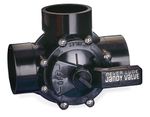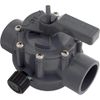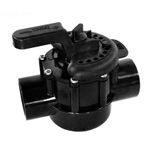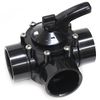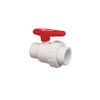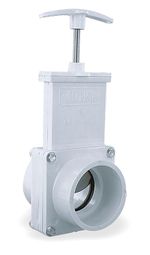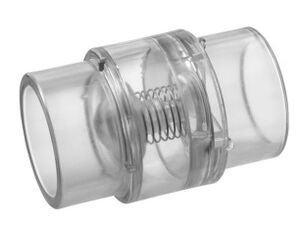| (26 intermediate revisions by the same user not shown) | |||
| Line 5: | Line 5: | ||
===Diverter Valves=== | ===Diverter Valves=== | ||
Motorized [[Valve Actuators]] can be screwed on top of a diverter valve for a pool automation system to change the valve position. | Motorized [[Valve Actuators]] can be screwed on top of a diverter valve for a pool automation system to change the valve position. | ||
| + | |||
| + | Diverters and check valves use the same body from a manufacture. You can change a check valve into a 2-way diverter or the reverse without cutting out the body and changing it. Check you are getting the correct size parts for the body size you have installed. | ||
====Jandy==== | ====Jandy==== | ||
| Line 17: | Line 19: | ||
[[File:Pentair Diverter Valve.jpg|150px|thumb]] | [[File:Pentair Diverter Valve.jpg|150px|thumb]] | ||
Pentair diverter valves are lube-free and never require lubrication. There are 2-way and 3-way models that accepts 1 1/2 in., 2 in., and 2 1/2 in. slip outside PVC plumbing. | Pentair diverter valves are lube-free and never require lubrication. There are 2-way and 3-way models that accepts 1 1/2 in., 2 in., and 2 1/2 in. slip outside PVC plumbing. | ||
| + | |||
| + | Pentair diverter valves come in PVC (grey) and CPVC (black) materials. | ||
Pentair diverters have a Fiberglass reinforced handle and can withstand pressure up to 150 psi. | Pentair diverters have a Fiberglass reinforced handle and can withstand pressure up to 150 psi. | ||
| + | |||
| + | If the stem is broken, you can turn the remaining part with a pliers to the "pool" position so you can circulate the pool while waiting for a repair. | ||
| + | |||
| + | The internal diverter a different shape in a Pentair diverter valve then a Jandy diverter valve. Putting a Jandy diverter in will not seal properly and leak. The diverters are specific to Pentair valves, part #270056 | ||
| + | |||
| + | [[File:Pentair Diverter.png|thumb]] | ||
| + | |||
| + | When replacing the screws, do not use a power screwdriver and do not over-tighten the screws as the valve body is very easy to crack if not very careful. | ||
====Hayward==== | ====Hayward==== | ||
[[File:Hayward Diverter Valve.jpg|100px|thumb|Hayward Diverter Valve]] | [[File:Hayward Diverter Valve.jpg|100px|thumb|Hayward Diverter Valve]] | ||
Hayward has 2-way and 3-way diverter valves in 1.5" x 2" and 2" x 2.5" sizes in CPVC and PVC materials. | Hayward has 2-way and 3-way diverter valves in 1.5" x 2" and 2" x 2.5" sizes in CPVC and PVC materials. | ||
| + | |||
| + | ====Opening a Diverter Valve==== | ||
| + | |||
| + | *When opening diverters, remove all screws and then tap the screw "flanges" on the lid 1/8" to rotate the lid clockwise or counter. | ||
| + | *Then you can tap upward on the lid flange and not need to jam a screwdriver to lift it. | ||
| + | *When putting the screws back, reverse first to line up the threads, then drop it in. *Using an hand screwdriver is recommended. | ||
| + | |||
| + | ====Fixing Diverter Valve Stripped Screw Holes==== | ||
| + | |||
| + | *Take the top off the valve<ref>https://www.troublefreepool.com/threads/stripped-valve-actuator-screws.211094/post-1850619</ref> | ||
| + | *Take a screw and coat it with Vaseline | ||
| + | *Fill the screw hole with epoxy | ||
| + | *Screw the screw in the hole | ||
| + | *Wait until the epoxy is almost set and back out the screw | ||
| + | *Wait until the epoxy full cures and put the top back on. | ||
| + | |||
| + | You do have to make sure not to let the epoxy set above the top of the screw hole. | ||
| + | |||
| + | Or | ||
| + | |||
| + | Fill both holes completely with putty and let dry, then drill a pilot hole and then create new threads with the screw.<ref>https://www.troublefreepool.com/threads/stripped-valve-actuator-screws.211094/post-1852053</ref> | ||
| + | |||
| + | ====Tips on Preventing Stripped Screws on Diverter Valves==== | ||
| + | |||
| + | #When installing the screws, turn the screw counterclockwise until it drops into the original threads and then go clockwise to tighten. Crossthreading will ruin the threads quickly.<ref>https://www.troublefreepool.com/threads/stripped-valve-actuator-screws.211094/post-1850971</ref> | ||
| + | #When installing an actuator, use the same manufacturer as the valve. The screw threads are different for different manufacturers and the screws will not go into the same threads. The original plastic threads will be damaged unless the threads match exactly. | ||
| + | |||
| + | ====Replacing Broken Grease Plug in Jandy Grey Diverter Valve==== | ||
| + | |||
| + | You can buy the [https://www.amazon.com/Jandy-4720-Diverter-Valve-Pools/dp/B009S8IEJ4 diverter kit] that converts the valve to a NeverLube and includes a red plug to go in the grease cap hole or you can buy a [https://www.amazon.com/Jandy-2133-Valve-Grease-Valves/dp/B001F6JAUY replacement grease cap].<ref>https://www.troublefreepool.com/threads/repair-of-leaking-jandy-valve.250828/post-2196739</ref> | ||
| + | |||
| + | The thread is 1/8" NPT and you can use a brass or plastic plug and buy the entire new Jandy valve and pull out the entire assembly from the body and install it into the existing valve. | ||
| + | |||
| + | [[File:Jandy Grey Diverter Broken Grease Plug Removal.png|600px|frameless]] | ||
===Ball Valves=== | ===Ball Valves=== | ||
| Line 38: | Line 84: | ||
===Check Valves=== | ===Check Valves=== | ||
| + | |||
| + | Flapper check valves are the most common type found on pools. Flapper check valves use a panel that is mounted on a hinge at one edge, to block the pipe. They need to be installed in the correct orientation to work correctly. | ||
| + | |||
| + | Spring check valves are found in older pools and where a flapper check valve is not recommended. A spring check valve uses a large spring that pushes a round plug up against the water flow. | ||
| + | |||
| + | [https://www.inyopools.com/HowToPage/how-to-select-a-pool-check-valve-overview.aspx How To Select a Pool Check Valve - Overview] Inyo Pools provides an overview of the function, description, and repair or replacement of flap and spring Check Valves. | ||
| + | |||
====Flapper Check Valves==== | ====Flapper Check Valves==== | ||
| − | ==== | + | Jandy, Pentair, Hayward, Waterway, and others all make flapper check valves that close using a spring. While they are all similar the internal parts are different. So you need to replace the flapper and lid assembly to match the brand housing you have glued into your pipes. The manufactures use different shaped flappers and springs. |
| + | |||
| + | [[File:Jandy Check Valve Flapper.jpg|thumb]] | ||
| + | |||
| + | Jandy has three sizes of check valve housing: | ||
| + | *1½” - 2” Valve - designed for both 1½” and 2” pipe. 1½” pipe slip-fits into valve ports. 2” pipe is joined using a 2” pipe coupling, a 45 degree elbow, or a 90 degree elbow. | ||
| + | *2” - 2½” Valve - designed for both 2” and 2½” pipe. 2” pipe slip-fits into valve ports. 2½” pipe is joined using a 2½” pipe coupling, a 45 degree elbow, or a 90 degree elbow. | ||
| + | *2½” - 3” Valve - designed for both 2½” and 3” pipe. 2½” pipe slip-fits into valve ports. 3” pipe is joined using a 3” pipe coupling, a 45 degree elbow, or a 90 degree elbow. | ||
| + | |||
| + | Jandy has a 180 degree housing where water flows straight through and a 90 degree housing where water flow makes a turn. | ||
| + | |||
| + | The internal valve assembly must be removed prior to gluing the valve body to pipe fittings. Make certain no glue enters the valve body beyond the ports. WELD-ON 724 CPVC GRAY IS RECOMMENDED. | ||
| + | |||
| + | Valve mounting for vertical installations is critical. Both Jandy Check Valve Installation Manuals say the Check Valve can be installed in horizontal piping runs or vertical piping runs with the flow running upward. | ||
| + | |||
| + | The [https://www.jandy.com/-/media/zodiac/global/downloads/7303.pdf?rev=d326cf5a03f149cf922e72f7d8e2bb50 Jandy Check Valve Installation Instructions] contains the following chart: | ||
| + | |||
| + | [[File:Jandy Check Valve Orientation.png|thumb]] | ||
| + | |||
| + | The [https://www.jandy.com/-/media/zodiac/global/downloads/h/h0292100.pdf?rev=12b653fcd5e84bd4b2c4ad28cdd1dae6 Jandy Pro Series Spring Check Valve Installation Instructions] has a different chart: | ||
| + | |||
| + | [[File:Jandy Pro Check Valve Mounting Chart.jpg|thumb]] | ||
| + | |||
| + | The top three wrong examples show downward water flow. The other three wrong examples show incorrect flapper positioning in the water flow. | ||
| + | |||
| + | Refer to the [https://www.jandy.com/-/media/zodiac/global/downloads/7303.pdf?rev=d326cf5a03f149cf922e72f7d8e2bb50 Jandy Check Valve Installation Instructions] or [https://www.jandy.com/-/media/zodiac/global/downloads/h/h0292100.pdf?rev=12b653fcd5e84bd4b2c4ad28cdd1dae6 Jandy Pro Series Spring Check Valve Installation Instructions] for additional installation details. | ||
| + | |||
| + | We see many check valves installed on vertical pipes with downward flow which is not recommended in the Jandy Check Valve Installation Instructions.<ref>https://www.jandy.com/-/media/zodiac/global/downloads/7303.pdf?rev=d326cf5a03f149cf922e72f7d8e2bb50</ref> The spring, gravity, and the weight of the water should all be working to keep the flapper closed. | ||
| + | |||
| + | [[File:Spa Return Check Valve.jpg|thumb]] | ||
====Spring Check Valves==== | ====Spring Check Valves==== | ||
| + | |||
| + | Pentair/Ortega makes spring check valves that are used for downward water flow in spa returns. | ||
| + | |||
| + | Check valve springs can be 1lb or 3lb with 1lb the most commonly used. There are some special cases where the outlet has enough pressure drop that tends to keep the check open that you need the 3lb spring. | ||
| + | |||
| + | Spring check valves with a 1/4lb spring can be used with a [[Spa Air Blower]] to reduce the risk of water getting back to the blower.<ref>https://www.troublefreepool.com/threads/check-valve-for-blower.223018/post-1953965</ref>: | ||
| + | |||
| + | *[http://www.inyopools.com/Products/00100028006837.htm Flo Control Air Blower] 1-1/2" x 2" 1/4 lb Sping Check Valve 1050-C2 | ||
| + | *[https://magicplastics.com/magic-plastics-products/compact-air-check-valves/?portfolioCats=31 Magic brand Pool Spa Air Blower Check Valve] 1-1/2" - 2" 1/4 lb Spring. | ||
| + | *[http://www.inyopools.com/Products/00400125042788.htm Air Supply Silencer Check Valve] 1/4 lb. Spring 1.5" I.D 2.0" O.D - 112500 | ||
| + | |||
| + | [[File:Check Valve Air Blower.jpg|thumb]] | ||
==On Filters== | ==On Filters== | ||
| Line 56: | Line 150: | ||
*S- generally means a slip fitting that is not threaded and must be glued | *S- generally means a slip fitting that is not threaded and must be glued | ||
| − | *FPT - female pipe thread. | + | *FPT - female(internal) pipe thread. |
| − | *MPT - male pipe thread | + | *MPT - male(external) pipe thread |
| + | |||
| + | FPT and MPT are types of [https://en.wikipedia.org/wiki/National_pipe_thread National Pipe Threads] FPT and MPT are tapered for sealing, often without any thread sealant. | ||
| + | |||
| + | PT, NPT, FPT acronyms have the same meaning for American National Standard Pipe Threads. Female NPT threads can be designated as FPT and male NPT threads can be designated as MPT. | ||
[https://cloudfront.zoro.com/img/zoro_tips/pipe_thread_definitions_eZtip.pdf Definition of Pipe Thread Acronyms] contains other acronyms, | [https://cloudfront.zoro.com/img/zoro_tips/pipe_thread_definitions_eZtip.pdf Definition of Pipe Thread Acronyms] contains other acronyms, | ||
Latest revision as of 18:28, 2 February 2024
Valves
On Pipes
Diverter Valves
Motorized Valve Actuators can be screwed on top of a diverter valve for a pool automation system to change the valve position.
Diverters and check valves use the same body from a manufacture. You can change a check valve into a 2-way diverter or the reverse without cutting out the body and changing it. Check you are getting the correct size parts for the body size you have installed.
Jandy
Jandy has two lines of high quality diverter valves - Grey and Never Lube. Both types of valves work the same way. The Grey valve has a grease cap that can be lubed without any dis-assembly. The Never Lube Valve is completely maintenance-free.
The valves come in 2 port and 3 port models. Both models are available in 1.5" x 2" and 2" x 2.5" sizes. The Never Lube is also available in 2.5" x 3" size.
This Jandy Parts Catalog has a complete list of valves and replacement parts.
Pentair
Pentair diverter valves are lube-free and never require lubrication. There are 2-way and 3-way models that accepts 1 1/2 in., 2 in., and 2 1/2 in. slip outside PVC plumbing.
Pentair diverter valves come in PVC (grey) and CPVC (black) materials.
Pentair diverters have a Fiberglass reinforced handle and can withstand pressure up to 150 psi.
If the stem is broken, you can turn the remaining part with a pliers to the "pool" position so you can circulate the pool while waiting for a repair.
The internal diverter a different shape in a Pentair diverter valve then a Jandy diverter valve. Putting a Jandy diverter in will not seal properly and leak. The diverters are specific to Pentair valves, part #270056
When replacing the screws, do not use a power screwdriver and do not over-tighten the screws as the valve body is very easy to crack if not very careful.
Hayward
Hayward has 2-way and 3-way diverter valves in 1.5" x 2" and 2" x 2.5" sizes in CPVC and PVC materials.
Opening a Diverter Valve
- When opening diverters, remove all screws and then tap the screw "flanges" on the lid 1/8" to rotate the lid clockwise or counter.
- Then you can tap upward on the lid flange and not need to jam a screwdriver to lift it.
- When putting the screws back, reverse first to line up the threads, then drop it in. *Using an hand screwdriver is recommended.
Fixing Diverter Valve Stripped Screw Holes
- Take the top off the valve[1]
- Take a screw and coat it with Vaseline
- Fill the screw hole with epoxy
- Screw the screw in the hole
- Wait until the epoxy is almost set and back out the screw
- Wait until the epoxy full cures and put the top back on.
You do have to make sure not to let the epoxy set above the top of the screw hole.
Or
Fill both holes completely with putty and let dry, then drill a pilot hole and then create new threads with the screw.[2]
Tips on Preventing Stripped Screws on Diverter Valves
- When installing the screws, turn the screw counterclockwise until it drops into the original threads and then go clockwise to tighten. Crossthreading will ruin the threads quickly.[3]
- When installing an actuator, use the same manufacturer as the valve. The screw threads are different for different manufacturers and the screws will not go into the same threads. The original plastic threads will be damaged unless the threads match exactly.
Replacing Broken Grease Plug in Jandy Grey Diverter Valve
You can buy the diverter kit that converts the valve to a NeverLube and includes a red plug to go in the grease cap hole or you can buy a replacement grease cap.[4]
The thread is 1/8" NPT and you can use a brass or plastic plug and buy the entire new Jandy valve and pull out the entire assembly from the body and install it into the existing valve.
Ball Valves
You can usually identify the manufacturer of a ball valve by it's handle.
Jandy has a line of Gold Standard Ball Valves with 1 1/2' and 2" with unions and 3/4' to 4" without unions.
Praher has a line of ball valves.
Repairs
You can buy new insides for the praher valves, easy swap out. You may need to buy an identical valve and use the internals.
Knife Gate Valves
Check Valves
Flapper check valves are the most common type found on pools. Flapper check valves use a panel that is mounted on a hinge at one edge, to block the pipe. They need to be installed in the correct orientation to work correctly.
Spring check valves are found in older pools and where a flapper check valve is not recommended. A spring check valve uses a large spring that pushes a round plug up against the water flow.
How To Select a Pool Check Valve - Overview Inyo Pools provides an overview of the function, description, and repair or replacement of flap and spring Check Valves.
Flapper Check Valves
Jandy, Pentair, Hayward, Waterway, and others all make flapper check valves that close using a spring. While they are all similar the internal parts are different. So you need to replace the flapper and lid assembly to match the brand housing you have glued into your pipes. The manufactures use different shaped flappers and springs.
Jandy has three sizes of check valve housing:
- 1½” - 2” Valve - designed for both 1½” and 2” pipe. 1½” pipe slip-fits into valve ports. 2” pipe is joined using a 2” pipe coupling, a 45 degree elbow, or a 90 degree elbow.
- 2” - 2½” Valve - designed for both 2” and 2½” pipe. 2” pipe slip-fits into valve ports. 2½” pipe is joined using a 2½” pipe coupling, a 45 degree elbow, or a 90 degree elbow.
- 2½” - 3” Valve - designed for both 2½” and 3” pipe. 2½” pipe slip-fits into valve ports. 3” pipe is joined using a 3” pipe coupling, a 45 degree elbow, or a 90 degree elbow.
Jandy has a 180 degree housing where water flows straight through and a 90 degree housing where water flow makes a turn.
The internal valve assembly must be removed prior to gluing the valve body to pipe fittings. Make certain no glue enters the valve body beyond the ports. WELD-ON 724 CPVC GRAY IS RECOMMENDED.
Valve mounting for vertical installations is critical. Both Jandy Check Valve Installation Manuals say the Check Valve can be installed in horizontal piping runs or vertical piping runs with the flow running upward.
The Jandy Check Valve Installation Instructions contains the following chart:
The Jandy Pro Series Spring Check Valve Installation Instructions has a different chart:
The top three wrong examples show downward water flow. The other three wrong examples show incorrect flapper positioning in the water flow.
Refer to the Jandy Check Valve Installation Instructions or Jandy Pro Series Spring Check Valve Installation Instructions for additional installation details.
We see many check valves installed on vertical pipes with downward flow which is not recommended in the Jandy Check Valve Installation Instructions.[5] The spring, gravity, and the weight of the water should all be working to keep the flapper closed.
Spring Check Valves
Pentair/Ortega makes spring check valves that are used for downward water flow in spa returns.
Check valve springs can be 1lb or 3lb with 1lb the most commonly used. There are some special cases where the outlet has enough pressure drop that tends to keep the check open that you need the 3lb spring.
Spring check valves with a 1/4lb spring can be used with a Spa Air Blower to reduce the risk of water getting back to the blower.[6]:
- Flo Control Air Blower 1-1/2" x 2" 1/4 lb Sping Check Valve 1050-C2
- Magic brand Pool Spa Air Blower Check Valve 1-1/2" - 2" 1/4 lb Spring.
- Air Supply Silencer Check Valve 1/4 lb. Spring 1.5" I.D 2.0" O.D - 112500
On Filters
Multi-Purpose Valve (MPV)
See MPV Valves
Slide Valves
See Slide Valves
Thread Types
There are confusing three letter and four letter acronyms that describe the type of threads on a fitting. The correct threads needs to used for screw in fittings to have a tight, strong, and leak proof connection. Common types used in pool plumbing are:
- S- generally means a slip fitting that is not threaded and must be glued
- FPT - female(internal) pipe thread.
- MPT - male(external) pipe thread
FPT and MPT are types of National Pipe Threads FPT and MPT are tapered for sealing, often without any thread sealant.
PT, NPT, FPT acronyms have the same meaning for American National Standard Pipe Threads. Female NPT threads can be designated as FPT and male NPT threads can be designated as MPT.
Definition of Pipe Thread Acronyms contains other acronyms,
- ↑ https://www.troublefreepool.com/threads/stripped-valve-actuator-screws.211094/post-1850619
- ↑ https://www.troublefreepool.com/threads/stripped-valve-actuator-screws.211094/post-1852053
- ↑ https://www.troublefreepool.com/threads/stripped-valve-actuator-screws.211094/post-1850971
- ↑ https://www.troublefreepool.com/threads/repair-of-leaking-jandy-valve.250828/post-2196739
- ↑ https://www.jandy.com/-/media/zodiac/global/downloads/7303.pdf?rev=d326cf5a03f149cf922e72f7d8e2bb50
- ↑ https://www.troublefreepool.com/threads/check-valve-for-blower.223018/post-1953965


